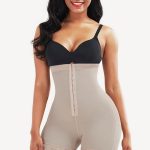When it comes to apparel sales, big is beautiful. To fuel growth, the fashion world is increasingly counting on plus-size customers, a demographic that it has long ignored.
According to market researcher NPD Group, sales of women’s plus-size clothing (defined as size 12 and above) rose 6 percent to $21.4 billion in 2016, double the rate of overall apparel sales. By 2020, revenue in the category could hit $24 billion, though Ascena Retail (ASNA), parent of plus-size chain Lane Bryant, argues that the “true opportunity” in the market may be as much as $53 billion, depending on how it’s measured.
Many in the fashion world have gotten the message that bigger is better, or they may be paying attention to research that has found the average American woman now wears a size 16 or 18, equal to a plus size 20w.
Walmart (WMT) in March unveiled plans to acquire independent online retailer ModCloth, which the retail giant described as a pioneer in the fashion industry on issues of “size diversity, lifestyle inclusiveness, and body positivity over the last decade.” Walmart didn’t disclose the deal’s price.
Designers including Michael Kors (KORS) and Christian Siriano featured “a range of body types on their fall runways,” while H&M included “shapely models” Kate Syme and Stela Duval in its collections, according to Women’s Wear Daily. Designer Prabal Gurung, whose clients include Oprah Winfrey among others, recently announced plans for a limited collection to be sold at Lane Bryant.
Earlier this year, sports apparel giant Nike (NKE) began selling plus-size workout clothes. Retailer JCPenney (JCP) last year unveiled its Boutique + collection for millennials in conjunction with “Project Runway” winner Ashley Nell Tipton. The Plano, Texas-based company plans to further expand its plus-size line this year with swimwear and other accessories. Big-box chain Target (TGT) unveiled its Ava and Viv collection in 2015.
According to a report from McKinsey & Co., the number of mentions of “plus size” in the fashion press tripled in 2016 compared with the previous year. The trend shows no signs of slowing.
“Fashion brands are rapidly responding to a cultural shift toward body positivity and a growing appreciation of curvy figures, by designing specifically for a larger range of sizes rather than just expanding their size range as an afterthought,” the report said.
However, traditional retailers such as Ascena, which also owns Catherine’s plus-size chain, will face tough competition from both brick-and-mortar stores and online rivals such as Amazon (AMZN). Comparable-store sales, a key retail metric measuring activity at existing locations, has fallen at Ascena’s Lane Bryant and Catherines as foot traffic declined. An Ascena spokesperson couldn’t immediately be reached.
Men’s big and tall fashions are also selling well at a time when large apparel chains such as Gap (GPS) are struggling to attract customers.
Destination XL (DXLG), the largest specialty retailer of big and tall fashions for men, reported positive comparable-store sales in three out of four quarters last year, which analyst Greg Pendy of Sidoti & Co. called “impressive relative to the overall industry.” He rates the stock a “buy.”
Helping the chain’s results have been strong demand from so-called “end of rack” customers with waistlines of between 38 inches to 46 inches, sizes that can be difficult to find at many retailers.
Said Pendy: “That’s been a bright spot for Destination XL to capture that opportunity.”
